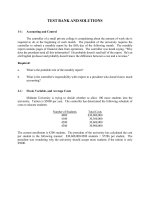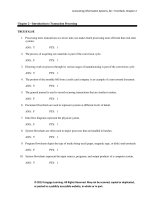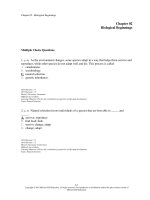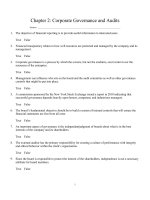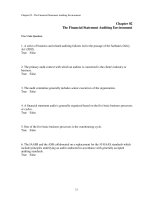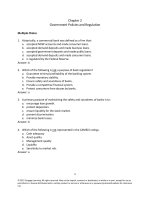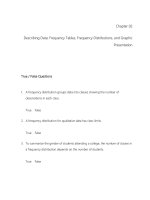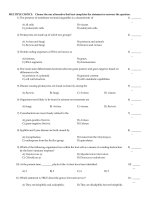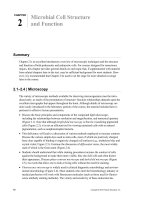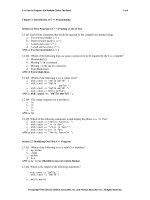Elements of ecology 8th edition smith test bank
Bạn đang xem bản rút gọn của tài liệu. Xem và tải ngay bản đầy đủ của tài liệu tại đây (141.34 KB, 11 trang )
Elements of Ecology, 8e (Smith/Smith)
Chapter 2 Climate
2.1 Short Answer Questions
1) The ability of the physical environment to support life is referred to as its ________.
Answer: habitability
Topic: Introduction to Chapter 2
2) The temperature, humidity, precipitation, wind, cloudiness, and other atmospheric conditions
that occur at a specific place and time are referred to as ________.
Answer: weather
Topic: Introduction to Chapter 2
3) The long-term average pattern of weather at local, regional, or global scales is referred to as
________.
Answer: climate
Topic: Introduction to Chapter 2
4) Carbon dioxide and ________ are the major gases in the atmosphere that absorb energy from
the sun.
Answer: water vapor
Topic: Section 2.1
5) The absorption and reradiation of longwave radiation by gases in the atmosphere is called the
________.
Answer: greenhouse effect
Topic: Section 2.1
6) The portion of the electromagnetic spectrum that is used by plants to power photosynthesis is
referred to as ________ active radiation.
Answer: photosynthetically
Topic: Section 2.1
7) Seasonality occurs on planet Earth because of its ________ with respect to the plane it travels
around the Sun.
Answer: axial tilt
Topic: Section 2.2
8) In the Northern Hemisphere, the summer ________ occurs when solar rays fall directly on the
Tropic of Cancer.
Answer: solstice
Topic: Section 2.2
9) The amount of force exerted over a given area of surface is called atmospheric ________.
Answer: pressure
Topic: Section 2.3
1
Copyright © 2012 Pearson Education, Inc.
10) The decrease in air temperature through expansion, rather than through heat loss to the
surrounding atmosphere, is referred to as ________.
Answer: adiabatic cooling
Topic: Section 2.3
11) Air masses are deflected to the ________ in the Northern Hemisphere and to the ________
in the Southern Hemisphere.
Answer: right; left
Topic: Section 2.4
12) The winds formed between the equator and about 30 degrees of latitude, blowing from the
northeast in the Northern Hemisphere and southeast in the Southern Hemisphere, are referred to
as ________.
Answer: trade winds
Topic: Section 2.4
13) In the Southern Hemisphere, oceanic gyres circulate in a(n) ________ direction.
Answer: counterclockwise
Topic: Section 2.5
14) The transformation of water from liquid to a gaseous state is referred to as ________.
Answer: evaporation
Topic: Section 2.6
15) ________ is the amount of water vapor in the air expressed as a percentage of the saturation
vapor pressure.
Answer: Relative humidity
Topic: Section 2.6
16) The ________ is the temperature at which atmospheric water condenses.
Answer: dew point
Topic: Section 2.6
17) The narrow region near the equator where trade winds meet is referred to as the ________.
Answer: intertropical convergence zone
Topic: Section 2.7
18) Rainfall is greater and the vegetation more dense on the windward side of a mountain range
than on the leeward side, where a(n) ________ is formed.
Answer: rain shadow
Topic: Section 2.8
19) A period of cooling that lasted from approximately the mid-14th to the mid-19th century is
referred to as the ________.
Answer: Little Ice Age
Topic: Section 2.9
2
Copyright © 2012 Pearson Education, Inc.
20) During an El Niño event, the waters of the eastern Pacific Ocean are unusually ________.
Answer: warm
Topic: Section 2.9
21) Most organisms live in habitats that provide specific conditions or a(n) ________ that may
be very different from regional weather patterns.
Answer: microclimate
Topic: Section 2.10
22) Temperatures in cities are several degrees warmer than those of the surrounding countryside,
a phenomenon referred to as a(n) ________.
Answer: urban heat island
Topic: Ecological Issues: Urban Microclimates
2.2 Multiple-Choice Questions
1) Habitability is the ability of
A) an organism to survive in a particular habitat.
B) the physical environment to support life.
C) the organism to take in resources.
D) the physical environment to change.
Answer: B
Topic: Introduction to Chapter 2
2) The two major atmospheric gases that absorb energy from the Sun are
A) oxygen and nitrogen.
B) nitrogen and hydrogen.
C) hydrogen and carbon dioxide.
D) carbon dioxide and water vapor.
Answer: D
Topic: Section 2.1
3
Copyright © 2012 Pearson Education, Inc.
3) Without the greenhouse effect, the Earth would
A) be much warmer than it currently is.
B) be much colder than it currently is.
C) have uniform temperatures and would lack seasons.
D) have constant sunlight.
Answer: B
Topic: Section 2.1
4) Only 51 percent of incoming solar radiation actually reaches Earth's surface. Most of the
remaining 49 percent of incoming radiation is reflected back to space by
A) clouds and the atmosphere.
B) the ocean's surface.
C) snow and ice.
D) land.
Answer: A
Topic: Section 2.1
5) Of the 51 units of solar radiation that reach Earth's surface, ________ units are lost to the
evaporation of water.
A) 51
B) 30
C) 23
D) 7
Answer: D
Topic: Section 2.1
6) Photosynthetically active radiation (PAR) includes wavelengths
A) shorter than visible light (ultraviolet light).
B) within the range of visible light.
C) only within the green spectrum of visible light.
D) longer than visible light (infrared radiation).
Answer: B
Topic: Section 2.1
7) Solar radiation in December is greatest at
A) the equator.
B) the Tropic of Cancer.
C) 90° in the Southern Hemisphere.
D) 90° in the Northern Hemisphere.
Answer: C
Topic: Section 2.2
4
Copyright © 2012 Pearson Education, Inc.
8) Seasonal variation in solar radiation, temperature, and day length is due to the
A) tilt of the Earth's axis.
B) greenhouse effect.
C) Coriolis effect caused by the spinning of Earth on its axis.
D) sunspot activities at the surface of the Sun.
Answer: A
Topic: Section 2.2
9) As altitude increases,
A) atmospheric pressure and temperature decrease.
B) atmospheric pressure decreases and temperature increases.
C) atmospheric pressure increases and temperature decreases.
D) atmospheric pressure and temperature increase.
Answer: A
Topic: Section 2.3
10) The rate of adiabatic cooling depends on the
A) amount of moisture in the air.
B) temperature of the air.
C) latitude.
D) season.
Answer: A
Topic: Section 2.3
11) The atmospheric region that is closest to the Earth's surface is called the
A) mesosphere.
B) stratosphere.
C) thermosphere.
D) troposphere.
Answer: D
Topic: Section 2.3
12) Of the following areas on Earth's surface, which area moves fastest and has the greatest
linear velocity?
A) North Pole (90° north)
B) Tropic of Cancer (23.5° north)
C) Tropic of Capricorn (23.5° south)
D) Equator (0°)
Answer: D
Topic: Section 2.4
5
Copyright © 2012 Pearson Education, Inc.
13) A scientist traveling on a boat from Alaska to Antarctica took daily measurements of
atmospheric pressure. At which latitudes were the lowest pressures found?
A) polar (~90°) and subpolar (~60°) latitudes
B) subpolar (~60°) and subtropical (~30°) latitudes
C) subpolar (~60°) and tropical (~0°) latitudes
D) subtropical (~30°) and tropical (~0°) latitudes
Answer: C
Topic: Section 2.4
14) Between 30°—60° north latitude, wind currents typically blow from
A) west to east and are deflected toward the left.
B) east to west and are deflected toward the left.
C) west to east and are deflected toward the right.
D) east to west and are deflected toward the right.
Answer: C
Topic: Section 2.4
15) The systematic patterns of water movement are known as
A) circulations.
B) currents.
C) gyres.
D) trade winds.
Answer: B
Topic: Section 2.5
16) Surface currents in the ocean typically
A) flow most strongly from west to east in equatorial regions.
B) are colder on the western side of continents.
C) flow counterclockwise in gyres in the Northern Hemisphere.
D) flow unimpeded from east to west just north of Antarctica.
Answer: B
Topic: Section 2.5
17) Relative humidity is the
A) amount of pressure at a given temperature at which water transforms from a liquid to a
gaseous state.
B) amount of pressure that water vapor exerts independent of the pressure of dry air.
C) temperature at which saturation vapor pressure is achieved.
D) amount of water vapor in the air relative to the saturation vapor pressure.
Answer: D
Topic: Section 2.6
6
Copyright © 2012 Pearson Education, Inc.
18) The transformation of water from a liquid state to a gaseous state is known as
A) condensation.
B) evaporation.
C) saturation.
D) solidification.
Answer: B
Topic: Section 2.6
19) In the vicinity of 30° north and 30° south, air typically
A) rises, cools, and precipitates.
B) descends, warms, and precipitates.
C) rises, cools, and is dry.
D) descends, warms, and is dry.
Answer: D
Topic: Section 2.7
20) During winter in the Northern Hemisphere, the intertropical convergence zone
A) sits directly over the equator.
B) is shifted into the northern latitudes.
C) is shifted into the southern latitudes.
D) does not exist.
Answer: C
Topic: Section 2.7
21) Precipitation is generally greater
A) in the Southern Hemisphere than in the Northern Hemisphere.
B) in coastal areas than in interior areas.
C) at the equator than at 30° of latitude.
D) on the leeward side of mountains than on the windward side.
Answer: B
Topic: Sections 2.7 and 2.8
22) As air rises over a mountain, it
A) cools and tends to lose moisture in the form of precipitation.
B) cools and tends to gain moisture without precipitating.
C) warms and tends to lose moisture in the form of precipitation.
D) warms and tends to gain moisture without precipitating.
Answer: C
Topic: Section 2.8
7
Copyright © 2012 Pearson Education, Inc.
23) Some variation in the solar radiation striking the Earth's surface is linked to ________
activity.
A) sunspot
B) El Niño
C) La Niña
D) glacial
Answer: A
Topic: Section 2.9
24) ________ is considered a primary influence on microclimate.
A) Aspect
B) Soil temperature
C) Rainfall
D) Vegetation
Answer: A
Topic: Section 2.10
25) In contrast with north-facing slopes, south-facing slopes in the Northern Hemisphere are
characterized by
A) a lower rate of evaporation.
B) greater soil moisture.
C) lower air temperatures.
D) more vigorous growth of mosses.
Answer: B
Topic: Section 2.10
26) Densely populated urban areas tend to have
A) higher relative humidity than rural areas.
B) higher temperatures than rural areas.
C) higher wind speeds than rural areas.
D) less fog than rural areas.
Answer: B
Topic: Ecological Issues: Urban Microclimates
2.3 True/False Questions
1) A hotter object emits longer wavelengths than a cooler object.
Answer: FALSE
Topic: Section 2.1
2) Most of the solar radiation arriving at the Earth's surface is reflected out to space.
Answer: FALSE
Topic: Section 2.1
3) Solar radiation is more direct in tropical latitudes than in temperate latitudes.
Answer: TRUE
Topic: Section 2.2
8
Copyright © 2012 Pearson Education, Inc.
4) Daylight in the Southern Hemisphere is longest during the winter solstice in December.
Answer: TRUE
Topic: Section 2.2
5) Atmospheric pressure increases with altitude.
Answer: FALSE
Topic: Section 2.3
6) Dry air cools more rapidly than moist air.
Answer: TRUE
Topic: Section 2.3
7) Masses of air and water are deflected to the right in the Northern Hemisphere and to the left in
the Southern Hemisphere.
Answer: TRUE
Topic: Section 2.4
8) In the vicinity of the equator, air warmed by solar radiation rises.
Answer: TRUE
Topic: Section 2.4
9) Oceanic gyres circulate in a counterclockwise direction in the Northern Hemisphere and in a
clockwise direction in the Southern Hemisphere.
Answer: FALSE
Topic: Section 2.5
10) The saturation vapor pressure of air increases with temperature.
Answer: TRUE
Topic: Section 2.6
11) Cold air can hold more water than warm air.
Answer: FALSE
Topic: Section 2.6
12) Rainfall in the Northern Hemisphere is greater than rainfall in the Southern Hemisphere.
Answer: FALSE
Topic: Section 2.7
13) Precipitation is higher in tropical regions than in temperate and polar regions.
Answer: TRUE
Topic: Section 2.7
14) Precipitation on a tropical island is greatest during June to August and lowest during January
to April. This island must be located south of the equator.
Answer: FALSE
Topic: Section 2.7
9
Copyright © 2012 Pearson Education, Inc.
15) Vegetation is usually more dense and vigorous on the windward side of mountains than on
the leeward side.
Answer: TRUE
Topic: Section 2.8
16) Surface temperatures in the eastern Pacific Ocean are warmer during El Niño conditions than
during La Niña conditions.
Answer: TRUE
Topic: Section 2.9
17) In temperate regions of the Northern Hemisphere, north-facing slopes are less humid than
south-facing slopes.
Answer: FALSE
Topic: Section 2.10
18) The average temperature in a city is greater than in the surrounding countryside.
Answer: TRUE
Topic: Ecological Issues: Urban Microclimates
2.4 Essay Questions
1) Explain the differences between weather, climate, and microclimate. Which is most important
for individual organisms? Give an example.
Topic: Introduction to Chapter 2 and Section 2.10
2) Explain how or why the Earth's surface emits more energy than it receives from the Sun.
Topic: Section 2.1
3) Explain why seasonal changes in temperature and daylight occur and why it is more
pronounced at temperate and polar latitudes than at tropical latitudes.
Topic: Section 2.2
4) Discuss the relationships between atmospheric pressure, temperature, and altitude.
Topic: Section 2.3
5) Explain how the trade winds develop and why these were so important to 17th-century
merchant sailors.
Topic: Section 2.4
6) Explain why the saturation vapor pressure increases with air temperature. How does relative
humidity change in response to air warming or cooling?
Topic: Section 2.6
7) Explain why more rain falls in tropical latitudes (~0°) than in subtropical latitudes (~30°).
Topic: Section 2.7
10
Copyright © 2012 Pearson Education, Inc.
8) Why do the amount of rainfall and the composition of vegetation differ greatly on the opposite
sides of a mountain range?
Topic: Section 2.8
9) Compare the causes and effects of the El Niño and La Niña events.
Topic: Section 2.9
10) You study two neighboring plant populations growing at 200 meters above sea level (asl).
One population is situated on a north-facing slope, whereas the other population grows on a
south-facing slope. Compare the environmental conditions and microclimates that each
population experiences.
Topic: Section 2.10
11) Why does the climate of urban areas differ from that of the surrounding countryside?
Topic: Ecological Issues: Urban Microclimates
11
Copyright © 2012 Pearson Education, Inc.
